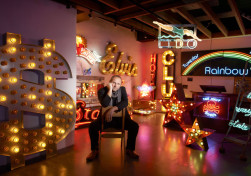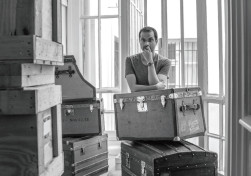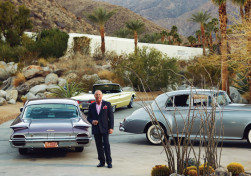Bracey's backyard in East London – christened “God’s Own Junk Yard” – is like Las Vegas’s Neon Boneyard in miniature: a four-decade jumble of industrial metal, discarded advertising signage, architectural salvage and, as he says, random letters that had been earmarked for recycling. His is a family trade – his father made neon signs, and Bracey has been beguiled by the art since he was a boy. The Londoner collects anything to do with old signs, and some of it he lovingly incorporates into new works of his own. “I might drag out an ‘L’ from a Planet Hollywood sign and an ‘O’ from the Trocadero and go on to spell out ‘LOVE’ on a backing board from an old First World War barracks,” he explains, describing the creative process. “I put it all together with old neon and bulbs, and then I fall in love with it. It’s carved from my heart.”
Other pieces he collects for the pure love of this vintage craft,
traveling the world to pick over old junkyards and secondhand shops. “I never throw anything away. I have loads of old signs my dad made for fairgrounds and circuses in the 1950s and 1960s, and then there are vintage American signs I found on road trips on Route 66,” he says.
Discarded neon from circuses, carnivals, end-of-the-pier joints,
London’s theaterland and Chinatown fill four warehouses across the city. Which has made Bracey the go-to guy as collector, artist and dealer when film companies want to recreate period sets for their productions. Batman’s Gotham City was propped with some of Bracey’s prized vintage signs, and Stanley Kubrick borrowed a few pieces and commissioned some new neon for Eyes Wide Shut. Vogue has shot fashion in his yard, and the artist Grayson Perry decorated a party with some neon that originally came from an old clip joint in London’s Soho.
These days, his own neon and colored-bulb artworks are garnering him a reputation internationally, with high-profile collectors such as Lady Gaga, Elton John and Mark Zuckerberg buying his pieces. At an exhibition of his work last winter, he showed one piece made from a weathered old metal stepladder, its surface thick with paint and plaster marks. He’d attached the words “Stairway to Heaven” in cool white scripted neon on its steps. “I’ve had the ladder for years and years,” he says, “I knew it would be useful one day.”





